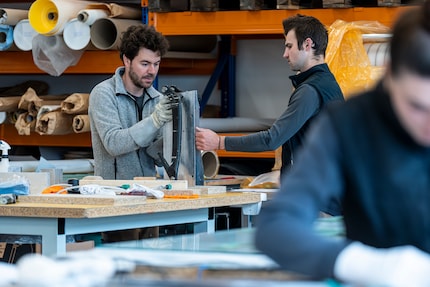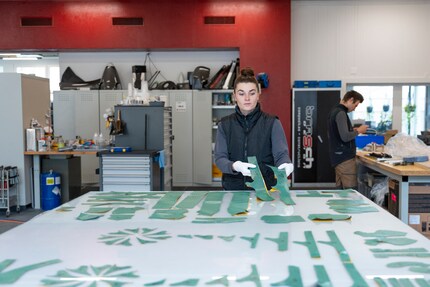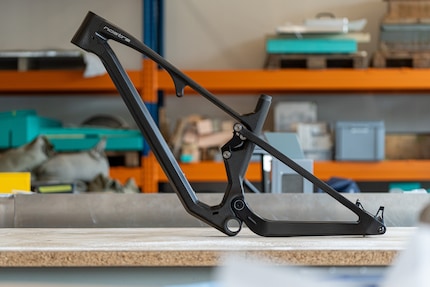Carbon bike
Would you spend that much money on a bike?
- No, that's too much.56%
- I would be prepared to pay that for Swiss Made and quality30%
- I just want to see the answers14%
The competition has ended.

Almost all bikes made of carbon are imported from Asia. Not so the bikes from Nostra. A small carbon forge develops and produces frames entirely in Switzerland. We got to take a closer look at this unique, highly complex craft.
The hills around Einsiedeln are shrouded in a thick blanket of cloud. It’s cold and rainy. At the end of the village stands a small industrial building with a large window front. The lights are on and there are people bustling about inside. I go through the doors of what used to be the canteen of a large electronics manufacturer and find myself in a different, fascinating world – the world of Brasch Design Composites.
There are carbon works-in progress everywhere I look. Company founder Roman Braschler’s customers include private individuals with special requests such as a carbon camping kitchen. Then there are industrial customers including the Swiss Bobsleigh Association and companies that require robotic arms for the production of pet bottles.
Recently, bikers have also joined their customer base. Together with Gamux Bikes, a company based in Wangen, central Switzerland, which is in charge of the kinematics, Roman and his team have brought a carbon bike «Made in Switzerland» to market maturity. «It’s a dream bike,» Roman Braschler and long-time-employee and co-developer Swen Kälin tell me.

«We’ve repaired quite a few carbon frames for private customers in the past and seen poor quality of workmanship in many of them. So we’ve been toying with the idea of doing a better job ourselves for a very long time now,» says Roman. Swen and Roman go on to say that they only found the frame quality to be good in two or three bike manufacturers. Although mass production in Asia makes for low prices, the quality also suffers as a result. And so, after countless hours of development, the Swiss carbon bike was finally created: the Nostra DC (DC stands for Down Country) with 130 millimetres of suspension travel at the front and rear. For the race-oriented riders, it can be set up with 120 millimetres of suspension travel. The bikes are not available off the shelf, which is why they’re sadly not available in our store. The buyer gets to choose the parts such as the suspension fork, drivetrain, brakes, rims or tyres. Next, a mechanic assembles the bike from the carbon frame and the selected components.
To assemble the front frame triangle, employee Manon Antener lays out the required parts on a large table. In the early days, Manon cut out all of the 148 prepregs by hand. Meanwhile, a cutting plotter does this step for her. One by one, she glues the cut-outs into the aluminium mould. This step alone takes a whole day. «We place the fibres in the moulds and compress everything under vacuum. This prevents the formation of air pockets, which significantly increases the durability of the frame,» Swen explains.
Mass-produced products are made in a cost-effective process. It involves foam cores that are encased in the fibre material so that a frame can be worked on by several people at once. «This saves time and money, but comes at the expense of precision. Air pockets and undefined fibre layers are the result,» says Roman. Faulty frames often have to be reworked during production.

Once all pre-cut prepregs have been placed in the aluminium mould, the two halves are joined together and sealed. The air’s pumped out and the aluminium block’s heated to over 110 degrees Celsius – the exact temperature remains a secret. This makes the resin liquify and the carbon fibres stick together.
The curing process is highly complex. Roman and his team carried out dozens of tests until everything was right and the result was satisfactory. The temperature needs to be set to a certain level so that the resin flows well. At the same time, the vacuum must suck out all the air. To achieve a perfect result, the inserted prepregs also need to be positioned precisely. The team heats the aluminium block for the rear part of the frame (rear triangle) with milled heating coils that are in the tool. The front part (front frame triangle) is subjected to a heating press. This is the only way to distribute the heat evenly over the large component. After three hours of heating, the aluminium mould is removed while it’s still warm. This is because the metal contracts as it cools down and would damage the carbon frame. If everything’s okay, holes are drilled into the frame for the cable guide or the bottle holder and the titanium and aluminium hardware’s glued in.

The rear triangle is manufactured using the same process. What’s quite tricky is to fit the pre-punched carbon parts into the narrow gaps and passages. Unlike the front frame triangle, the aluminium shape doesn’t consist of two parts, but of nine parts due to its complex shape. Demoulding from the nine-part aluminium mould is therefore more complicated and time-consuming. The swing arm, as the rear triangle is also called, consists of two parts that are joined together after curing. How this is done exactly is Roman and Swen’s well-kept secret. Each manufacturer has its own process. Due to its complicated shape and the integrated cable guides, the swinging arm’s a very complex component and takes longer to manufacture than the larger front frame triangle.
Painting is also carried out in-house and can be done according to customer requirements. Nevertheless, Swen recommends a standard paint finish: «Most customers are overwhelmed by the endless possibilities. So it’s easier to opt for our standard paint finish.» It takes over 50 working hours to insert the carbon fibres into the moulds, cure and paint them, and finally assemble them.
In the neighbouring village of Trachslau, a small company manufactures all the additional metal parts required. This includes the 5-axis milled rocker (rocker link that connects the frame and shock) made of aluminium as well as aluminium and titanium bolts that are needed for a complete frame kit. The twelve locally produced screws and aluminium parts cost around five times more than their equivalents made in the Far East. «We focus on local added value and want to offer our customers a product that’s not only functional, but also ecologically sustainable,» says Roman.
The complete frame with rear triangle, linkage and titanium bolts weighs a slender 2,200 grammes. And yet, there are lighter bikes on the market. Instead, Roman and his team have paid particular attention to durability and robustness. Their aim is to ensure that any falls and crashes are better absorbed. At the same time, this should allow professional riders to only reach their own limits, not those of the equipment.
In order to achieve a very high drive efficiency, the team has worked on a particularly good torsional reinforcement, which means resistance of the frame to torsional forces. From the steering head where the handlebars are attached, to the bottom bracket where the pedals are attached – high-strength carbon fibres are used throughout. «We’ve made other areas of the frame a little more elastic. With this mix, we achieve outstanding strength and rigidity where it’s needed and where the highest forces are at play,» Roman explains.

«We’re incredibly proud that we’ve managed to prove with this project that it’s possible to bring production back to Switzerland from the Far East. It’s still more expensive. But with technology and automation, the chances are good that we’ll be able to produce competitively in Switzerland in the future,» says Roman. However, this isn’t always easy to explain to people. They’re often incredulous and surprised when they hear that the bikes are made in Switzerland. Swen says he usually has to show interested people photos of the production until they actually believe it. «We are simply no longer used to time-consuming processes being carried out in Switzerland,» adds Roman.

The plan is to make more than a few dozen carbon frames in Switzerland. If Roman and Swen have their way, this is just the beginning. They want to make the frame kits, which currently cost around 7,000 francs, available to a wider audience. Continuous optimisation and production automation should bring down the costs. «We want even more people to be able to enjoy a high-quality carbon bike from Switzerland,» explains Roman. Depending on the components, customers pay between 12,000 and 14,000 francs for a complete bike. That’s about as much as very expensive bikes from other manufacturers cost. Finally, the two reveal a little secret: «We already have a new, faster vehicle in the pipeline.» They’re working on a Nostra racing bike, also made in Einsiedeln.
In the meantime, the weather in Einsiedeln has improved. The clouds have slowly given way to the sun. Roman, Swen and Manon, all keen bikers, want to go for a spin on their bikes in the evening. On a Nostra, of course.
Would you spend that much money on a bike?
The competition has ended.
160 people like this article
As a Multimedia Producer, preparing multimedia content and knowing about cutting-edge technology is my business. My main focus at digitec is producing videos. I can’t wait to try out new products such as cameras, drones or smartphones as soon as they’re launched. This is where being at the source comes in rather handy. When I’m not working, I’m probably skiing, biking or hiking – the mountains are my place to be.